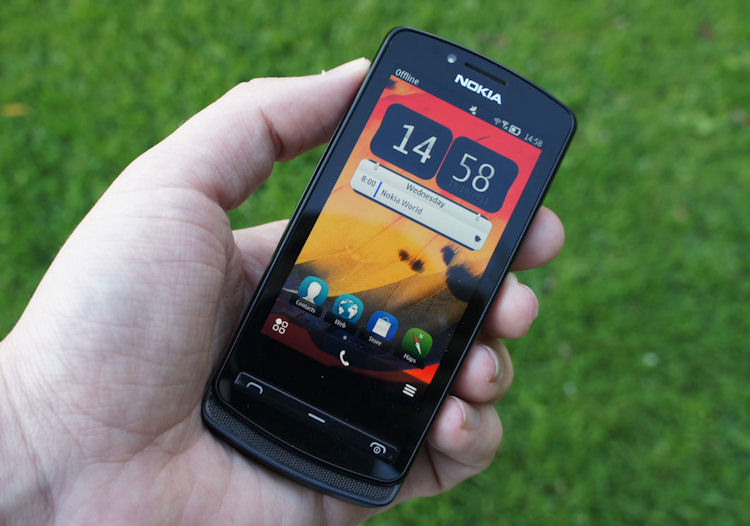Review: Nokia 700, part 1: hardware and OS overview
Score:
83%
This is the first Symbian Belle smartphone to be formally reviewed on All About Symbian, though of course we've covered the new OS update in some depth previously. The 700 is billed as the "smallest smartphone in the world" (being only 50cc in volume) and, within that context, it's superbly functional, with a full suite of most things we've already seen and enjoyed in previous Symbian^3 phones, all in an incredibly compact form factor. Standouts for me on the hardware front are the screen quality, the feel of the aluminium battery cover and the decent forward-facing speaker.
Key hardware specifications
- 110 x 50.7 x 9.7mm, 96g in weight, 50cc in volume; monoblock touch form factor
- NFC (Near Field Communications) with tap and share, and tap and pair
- Extensive use of eco friendly materials, which makes the Nokia 700 Nokia's most environmentally friendly phone
- Processor: ARM 11 at 1GHz with 2D/3D Graphics HW Accelerator (OpenVG 1.1 and OpenGL ES 2.0), RAM: 512MB
- 3.2" capacitive AMOLED ClearBlack touchscreen, with Gorilla Glass on top and a reduced air gap; 640 x 360 pixels resolution (nHD)
- 5 megapixel full focus (EDoF) camera (with LED flash); video capture at 1280 x 720p (HD - 720p at 30 frames per second)
- Integrated GPS with location support for A-GPS, WLAN and Cell-ID location techniques
- Compass (magnetometer), accelerometer, proximity and ambient light sensors
- microUSB (USB 2.0) for file transfers, charging and USB OTG
- 2mm charger port with AC15 (high effiency charger) in the box
- 3.5mm Nokia audiovisual port (stereo audio out and composite TV-out)
- BP-5Z (1080mAh) battery with easy access battery cover (standby time of 19 days and talk time of 7.3 hours (GSM) and 4.7 hours (WCDMA). Up to 47 hours of music playback and 6.9 hours of video playback
- WCDMA 850/900/1700/1900/2100 (pentaband 3G) and GSM/EDGE 850/900/1800/1900 (HSDPA Cat 10 - 14.4 Mbps, HSUPA Cat 6 - 5.76 Mbps)
- WiFi: WLAN IEEE 802.11 b/g/n and Bluetooth 3.0
- 2GB mass memory and microSD card slot (supports sizes up to 32GB)
- Available Q3 2011 in Cool Grey, Silver/White, Coral Red, Peacock Blue and Purple
- In box contents: Nokia 700, Nokia Battery BP-5Z, Nokia Connectivity Cable CA-179, Nokia Headset WH-207, Nokia High Efficiency Charger AC-15 and NFC gift card linking to Ovi Store apps (selected markets).
Materials, form factor and build
One important caveat aside, the design and build of the Nokia 700 is pretty good. The feel of the Gorilla Glass front, the aluminium back (battery cover) and the solid plastic chassis is top notch, it's hard to fault the phone's hardware and it feels like a high quality product. Being a little picky, the battery cover can be depressed slightly, i.e. it stands away from the battery underneath, but in fairness you do have to press fairly hard to make this happen or notice the effect.
I was testing the 'cool grey' variant, but to my eyes it seemed more like 'gunmetal grey' and even 'black' under some lighting - as ever, take the proferred colours with a pinch of salt.
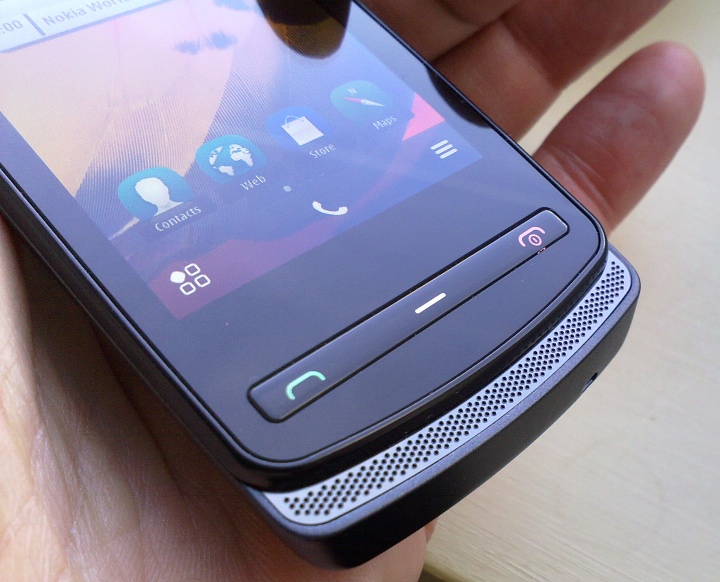
Aside from the tiny physical depth of the 700, the design is dominated by the speaker grille at the bottom, clearly styled to indicate that there's a decent speaker underneath. After some testing, I'd rate the speaker quite highly, it's possibly the same component used (albeit in duplicate) in the 5800 and X6 and sounds extremely crisp, with no high frequency loss due to there being plastic in the way (as on the X7 - twice, you may remember). The speaker itself is still less than a centimetre in length, so the full width grille is a little misleading, but I was still impressed overall with the sound coming out of the 700.
Being a touch-driven phone, the display is of the utmost importance, of course. And it's of terrific quality, possibly the same component used to great effect in the C6-01 that predates this 700. The ClearBlack Display technology works superbly and the nHD display is very crisp and clear, with that 'painted on' look we've seen in the C6-01 and E7 before it. Given that the 700 is arguably a direct descendant of the popular 5800, it's instructive to put the two devices side by side: the 5800 is far more bulky and its display far, far less impressive - in all light conditions.
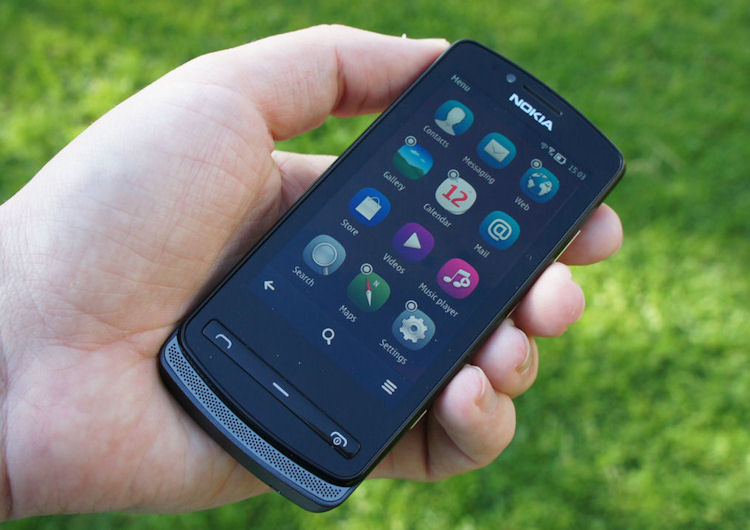
I do have one complaint though - the display would have been ever more stunning and the device as a whole even more impressive, if Nokia had squeezed in a 3.5" display rather than the 3.2" unit here. It may be that something had to give in terms of cost, or it may be that there's an underlying technical reason why the screen can't extend further down the body of the 700, but there's almost a full centimetre of wasted real estate between the plastic button strip and the bottom of the screen - with another half a centimetre wasted below the button strip. The design is a 'fait accompli', of course, but the frontal wastage is still an annoyance to anyone who's looking for the largest display in the smallest form factor.
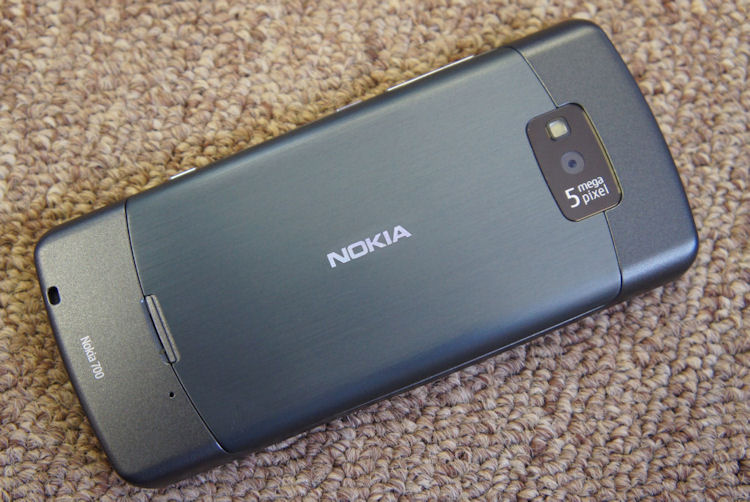
On the back of the 700, there's a 5 megapixel EDoF camera, an odd downgrade from the C6-01 component, although I'm guessing that the physical depth of the 700 (under 9mm according to my ruler, no matter what the specifications claim) had a lot to do with component choice - the camera sits underneath the screen component and there really wasn't a lot of room for a camera of any kind. I'll cover the camera more in part 2 of this review - suffice it to say that it's quite disappointing - just because it's 5 megapixels doesn't mean that it's up in the same leagues as the 2007 Nokia N95.... Image quality is significantly lower than that from the C6-01, also EDoF, of course. There's a (token) single LED flash and, at the bottom of the battery cover, a single point catch that does a decent enough job of keeping the phone clipped together.
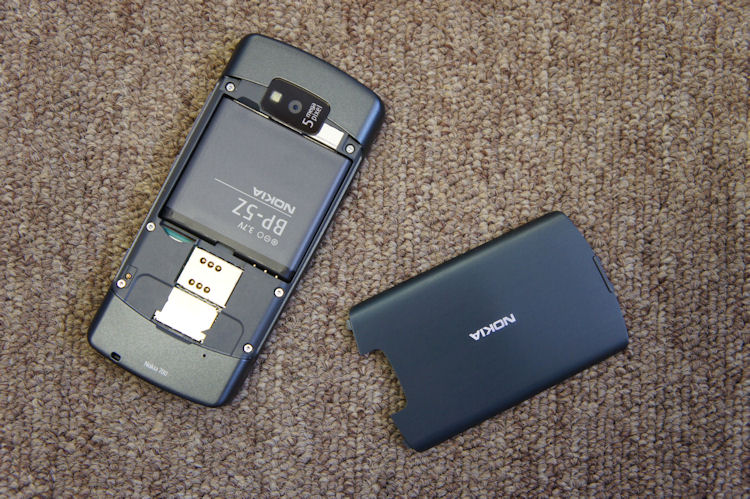
The battery is a new one to me, the BP-5Z, rated at 1080mAh, on the small side for a Symbian smartphone but then the C6-01's battery was of slightly lower capacity and seemed more than up to the job. Devices with 3.2" screens tend not to be used for the same intensive media viewing and web browsing that, say, the likes of the E7 and competing 4" Android smartphones have to endure, so a comparatively small battery can prove more than enough. In typical hands, the 700 will easily get through a day of use, possibly two if used sparingly.

Down the right hand side of the 700 are a strip of necessarily thin, stylised chrome effect buttons, for volume up/down (and zoom in/out, in the appropriate applications), for the camera (virtual) shutter 'release' and, interestingly, a keylock button rather than a sprung 'toggle' switch. In use, you press this button (or the 700's main 'home' button) and then tap the 'Unlock' button that appears on screen. It's not as quick or convenient as the sprung switch system, but it's simpler, it's workable and Nokia's support desks will probably have to listen to less customers complaining about 'rattly' (or lost) keylock switches.
Internals and performance
Under the hood of the Nokia 700 we have the next generation of Symbian hardware, running at 1GHz and, importantly, with 512MB of RAM. The Symbian^3 generation devices largely coped with 256MB of RAM, only failing to keep everything running when particularly large 'HD' games were played, it's fair to say that the Symbian Belle phones with double the RAM are future proofed to a significant degree. The faster processor (c.f. 680MHz on the likes of the N8 and E7) helps keep the interface nicely responsive, powering through where the older devices would lag slightly.
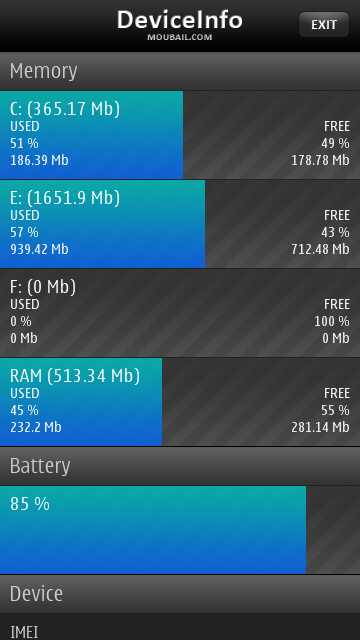
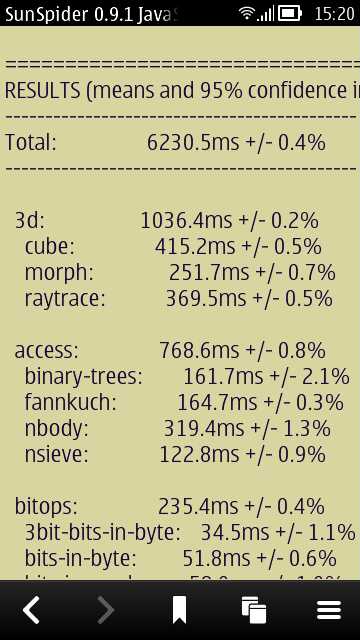
I ran the SunSpider benchmark in Web and got 6374ms, which compares well with single core Android smartphones from earlier in the year (remember that the top Android 'superphones' are mostly dual core now, with 1.2 and 1.4GHz processors). Importantly, Symbian Web has come in leaps and bounds in terms of compatibility (as well as performance) - Web on the N8 wouldn't even complete the SunSpider benchmark.
One good real world test of performance is to zoom into a high resolution photograph and see how long the software takes to bring up the crisper, more detailed view. On the Nokia 700, zooming right into a 5 megapixel photo, the production of a crisper version of the image took around a second. Compare this around three seconds on the N8 and E7, albeit zooming into 8 megapixel and 12mp images respectively. So things are definitely faster all round.
I mentioned the cut-down screen size above - the supplied flash memory also shows signs that build cost was important to Nokia in the 700 - there's only a meagre 2GB of mass memory supplied and no microSD either in the box. Every single Nokia 700 user is going to have to rummage in a drawer or head out to the shops again, to find a decent sized microSD card - I'd suggest an 8GB card as a bare minimum. 2GB is fine for your country's maps and occasional downloads, but users will want a lot more space for music and media files.
The phone radios are pentaband again, of course, so you should get 3G data almost anywhere in the world (network contracts and agreements notwithstanding), plus there's the usual Wi-fi and advanced Bluetoth profile set.
Sensors include GPS, accelerometer and magnetometer, and I was very pleased to see both 2mm and microUSB charging - such flexibility is very useful when on the road.
Software overview
Nokia was onto a hiding with the Belle update, whichever way it went. The initial plans for a radical overhaul of the Symbian UI in 'Symbian^4' got shelved and then it was down to incremental updates by way of Anna and then Belle to draw level with competing mobile user interfaces and their responsiveness, all with ever-dwindling resources in the face of increased investment in Windows Phone for 2012 and beyond.
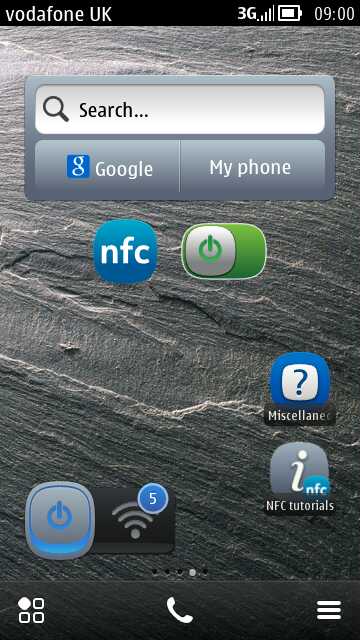
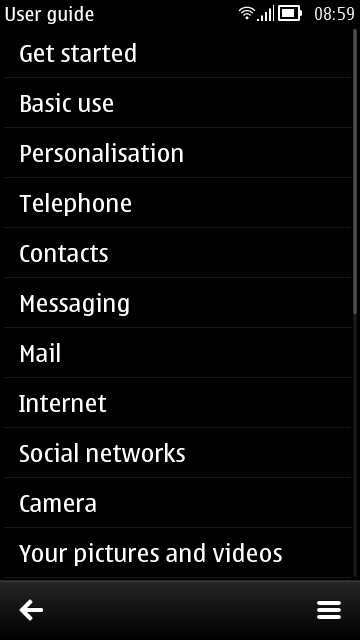
One of the new homescreens, ready for customisation, plus the facelifted 'User guide' (Help) system
With Belle, Nokia has taken Symbian's UI significantly towards the competing Android (and other mobile) OS, with:
- Pull-down notifications (and easy comms settings access) - this works well enough, even though it does seem rather strange pulling down a 'blind' Android-style on a Symbian smartphone. I'm sure we'll get used to it!
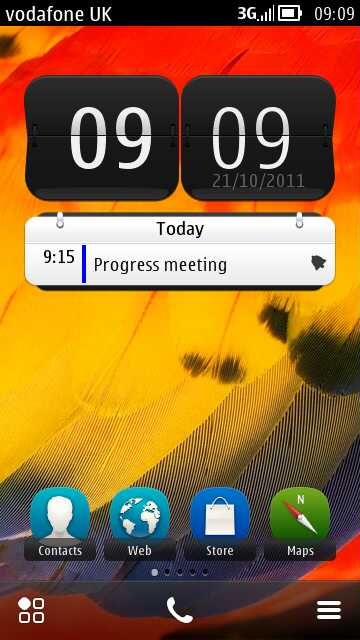
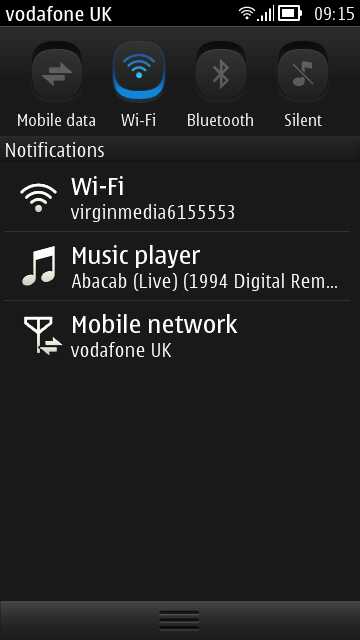
- A single big applications list rather than organisation into folders (though these can be created and used by power users if needed). This increase in application 'entropy' is a backwards step for experienced S60 and Symbian users, but will be welcomed by new users who aren't used to the 'classic' folder setup. In fairness, this 'classic' setup used to vary from device to device - maybe if Nokia has stuck to one single arrangement then a revamp wouldn't have been thought necessary?
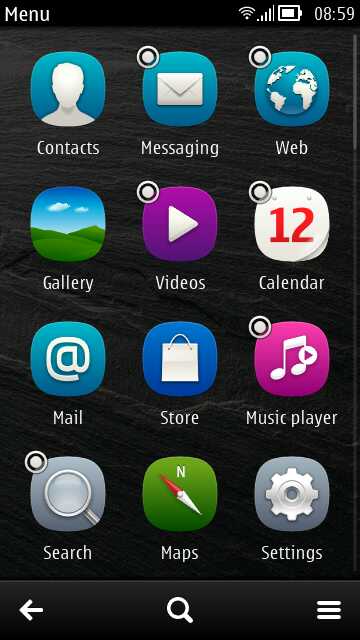
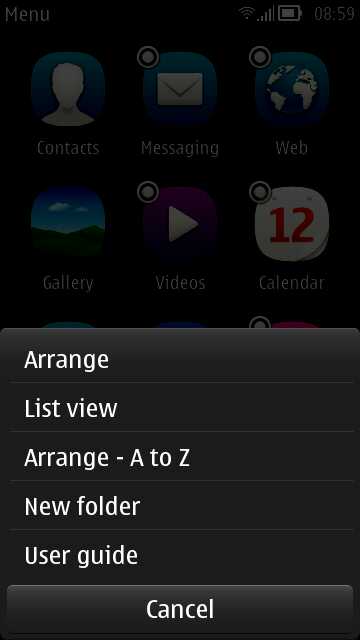
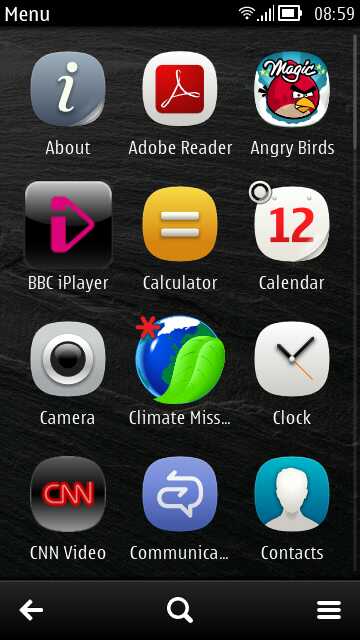
Note that the 'flat' applications list can be arranged alphabetically if needed (and reverted to the custom order later on, i.e. toggled between the two layouts)
- A 'back' button methodology for guiding a user back to what they were doing before they started looking at the current screen. So, rather than jumping from application to application and often getting confused over whether they were quitting the current app or not, new users will now simply press 'Back' until they get to a launcher pane or other screen where they can continue as needed. Power users will, of course, use the built-in application switcher (press and hold the 'home/menu' button) to jump between running applications. This change fits in better with how Android, iOS and Windows Phone work and so will hopefully feel familiar to anyone with experience of other 2011 smartphones, though it does occasionally mean more screen taps to achieve the same end.
In addition, there have been:
- Changes in the use of screen real estate, with slimmed down top status bar, meaning that more content can be shown. The bottom toolbar is also slimmer and the functions that used to be tied to the old 'Options' menus are now either avoided through UI changes or tied to the 'More' icon on the right side of the toolbar. Overall, a positive change and one that's right in line with these devices now being touch driven rather than d-pad and soft-key driven.
- Changes in what's allowed on the homescreens. For a start, there are now up to six homescreens (three set up by default) and widgets can now be one, two or four icons wide (the last corresponding to the traditional Symbian^1/^3/Anna widget size), and either one or two icons/slots high. You can't resize widgets dynamically - or at least not yet, but it does make for much more creative use of homescreen space.
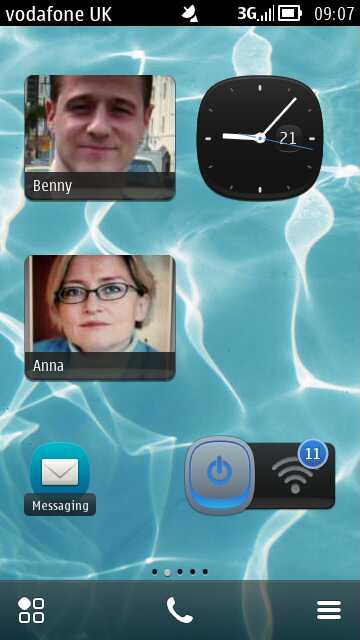
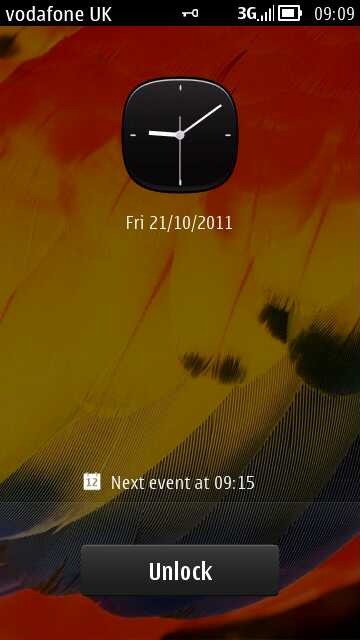
- The addition of NFC support, providing tag reading, content sharing and other functionality, detailed here.
Plus minor updates to many core Symbian applications, including Web and Music player. Taken as a whole, it's a big step up from Symbian Anna and Symbian^3, and must seem like an entirely different OS to someone used to a two year old Nokia 5800, for example. Even if some of the changes are arguably more geared to helping newcomers to the platform that helping old hands adapt!
There are still areas where Symbian is outgunned in 2011 - the virtual qwerty keyboard still doesn't support multi-touch, meaning that you have to deliberately slow your typing down so that keystrokes don't overlap each other - and the diminutive 3.2" screen really doesn't help speed text input. Nokia Social is still very primitive, especially in comparison to the social integration on Nokia's new smartphone platform, Windows Phone, as I remarked in depth recently.
But there are areas where Symbian still leads the way, of course. Good use of power means decent battery life, the fully open file system is super to work with, Bluetooth functionality is unrivalled, video codec support is excellent and the range of bundled apps, out of the box, is unmatched anywhere else in the mobile world.
Summary and review plan
In short, the Nokia 700 is clearly one of the most powerful (in terms of processor, RAM and OS) Symbian smartphones yet released, all in the smallest ever form factor. The latter will prove a stumbling block to those who want a larger screen, or a keyboard, or a better camera, but then the 700 isn't, I'll wager, aimed at any regular All About Symbian readers. The 700 is aimed at newcomers to Nokia's Symbian line-up. They'll be attracted by the build materials, by the size, by the 'modern' homescreen, by the screen clarity. And, with 1GHz and 512MB of RAM to back it up, Symbian Belle does a great job of providing a very useable smartphone experience, even for people who didn't know they wanted a smartphone in the first place.
In part two of this review of the Nokia 700, I'll look at its 'disappointing' camera functions, at multimedia playback and at its connectivity, while in the final part three, one of the All About Symbian team will provide a long term review perspective on living with the 700 day in, day out, exploring the good and bad in its application set and overall functionality.
Steve Litchfield, All About Symbian, 23rd October 2011
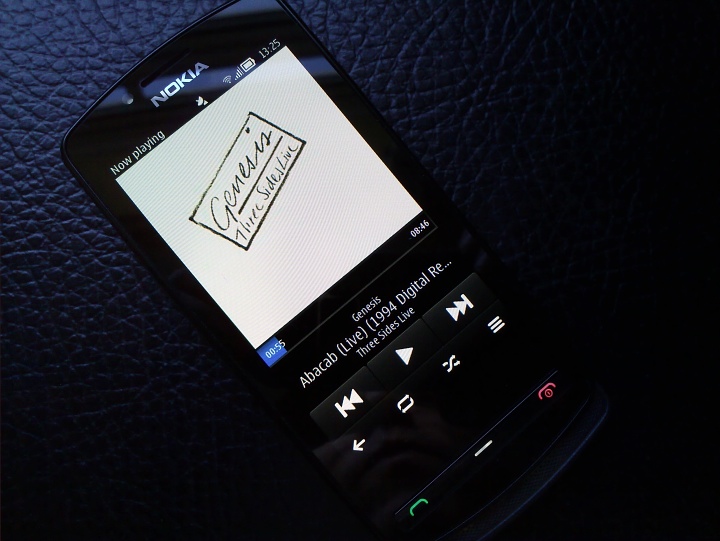
A lovely illustration of the beauty of AMOLED screens, especially in CBD form here on the Nokia 700,
here showing the 'blacker than black' blacks in Music player - you really can't see where the
screen ends and the black plastic frontage begins!
See Also
Reviewed by Steve Litchfield at

